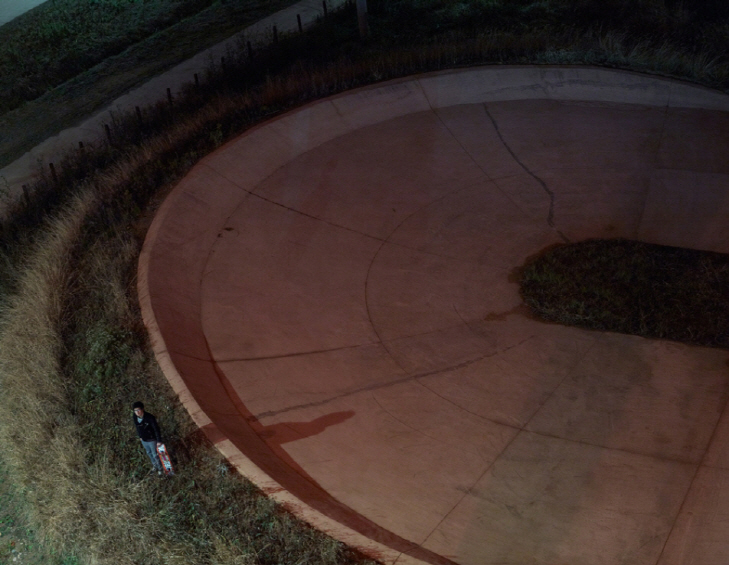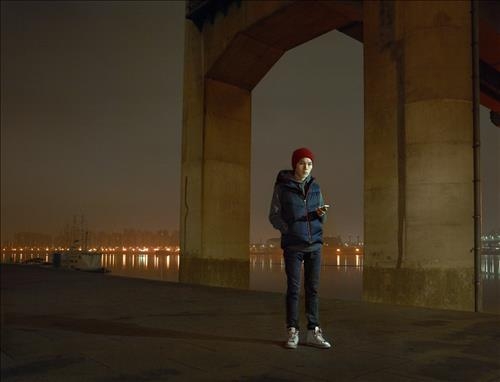Kim
Taedong's solo exhibition, 《Planetes》 is an exhibition selected for the
6th Amado Photography Award. In this exhibition, the artist presents a series
of < Rifling > and new works of < Planetes >. Both series were
inspired by the Real DMZ project, which was launched in 2015. In these two
series that seem to be different but somehow connected, the artist captures the
history which the war has left behind, the place of daily life, and the light
of the distant world beyond it in a strange yet beautiful way.
From
the series of < Symmetrical >(2010~) and < BreakDay>(2013~), which
reveals the characteristics of the places that capture the city but away from
the center and people who survives in there, to the series of , which allows anonymous people to coexist with the city's night-site,
the artist continued to describe the cityscape he faced or contemporary people.
The reason these works preserved some novelty or unfamiliarity is that the
artist intentionally paid attention to the surroundings or unusual lifestyles.
Since then, the artist has arrived in the area where the Korean War and the
division system have been preserved. The journey to the DMZ, a place where the
division of the South and the North is starkly divided, maybe natural for the
artist, who wanted to capture some conflict arising at the geopolitical
position of the city surrounding or the boundary, but on the other hand, it was
a new challenge and adventure because it has historical and military
significance.
The
artist goes through a series of the study process, including searching for
historical documents and photographic materials to enter the sites. However,
when capturing the sites with photos, the artist avoids practical methods such
as documentary photography. Therefore, the use of night time as a stage for
< Rifling > series follows the way the artist has been done before. What
the artist met on the Gyeongwon
Line(Dongducheon-Soyosan-Choshengli-HantangRiver-Jeongok-Yeoncheon-Shinkwangri-Sintan-Baekmago)
was not the intensity of the war, but the scenery of the rural village.
However, these areas were the exploitation paths during the Japanese colonial
and the places where bear the scars of the Korean War and some hope of the
unification which contains historicity. The artist could not overlook the
particularity of these places, so he captures the tension behind the everyday
scenery with the silence of the night. Notably, the work < Rifling >,
which did not focus on the stars in the night sky, is a bit dramatic in the
present, where history and everyday life coexist. The < Rifling > which
features scenery of a road created by dawning fog and red-lighted street
lights, seems to guide audiences to the unknown world, and the real-life scenes
he met on the road, such as military official residence(Rifling-017) and guard
post (Rifling-026), also capture some mysterious journeys. The bullet trace
left on the ceiling of the historical site of the Waterworks Bureau
site(Rifling-005), the crumbling wall of Donducheon old commercial
building(Rifling-019), and the village man who met in Shinmang-Ri
(Rifling-039), they are the reality but create unrealistic atmosphere. Rather
than evoking forgotten history, the artist brings up today's time in a strange
way, as if to give mysterious powers to those places.
The
early works of the series, < Rifling-011 >, is the starting point where
the artist has become interested in the night sky stars. He became aware of the
contradictory beauty of the night sky stars, unlike the atmosphere of the wet
and cold site at the time. That is how the < Planetes> series began. Now
there is a curious encounter between the war site and the remaining monument
and the night sky stars. The camera's focus will be onthe stars in the sky, and
astronomical photography will be studied to fix the stars. As a result,
war-related places, which were limited to the DMZ, will be expanded to various
parts of the country. Monument and veterans' weapons such as the Incheon
Landing Operation Memorial (Planetes-003), the Jangsa Coast Guard Memorial (Planetes-018), the
Dongducheon Peace Museum, the Ganghwado Island Korean War Veterans Memorial
Park (Planetes-030) will be the subject oft he photos. Furthermore, the <
Planetes Project, AU > which photographed Canberra, Sydney, the Korean War
Memorial, will be followed. After a long process, the more stable the positions
of the stars, the more blurred and shaky the building or monument on the ground
becomes. The Waterworks bureau site(Planetes-001), Seungilgyo (Planetes-014),
the Workers' Party (Planetes-004), Daemari Minbuk Village houses
(Planetes-005), and various Monumentaries are also in contrast to the bright
and vivid stars of the night sky. They show signs of shaking while maintaining
some of their original statues, which sit under the twinkling night sky as if
they were trying to escape without discerning their historical nature.
For
the past five years, the artist has visited historic sites related to the
Korean War. How to look at the present of those histories has been a question
for a long period of time, and it has not defined yet. Through this process,
the artist undergoes an emotional change and goes through a process of
development. The history and daily lives of those sites, which were the
starting point, move to a different level by exposing a staging scene beyond a
documentary photograph and then being distracted by the night sky star at one
point. Are the night sky stars and war sites inevitable? Maybe it brings back
the scars of the past to the aesthetic level. Despite these concerns, the
artist reminds us that the Earth is constantly fluctuating by trying to catch
the stars in the night sky. He might have seen the simple fact that even a
terrible war was created by those who lived in that era and that our lives now
continue on that scar. The world which the artist has been captures may be so
beautiful to tell the simple truth.
Therefore,
even though the artist has been visited the war sites, he did not abandon the
attitude to capture the city and the people which he has met. The artist
neither wants to expose the scars or wounds of history nor intends to reveal
any value judgment on historical facts. Instead, he intends to capture the
unique scenery he saw at the place he met not as an event or story, but as a
strange or conflicting image in the medium of photography, and meet the
imagination of the viewer.



















